Documenting the Amenhotep III Wall Scene LD177 at Luxor Temple (Part 4) - From Model Creation to Presentation
Written by Owen Murray, Senior Digital Photographer at the Epigraphic Survey of the Oriental Institute, University of Chicago and Alexis Pantos, MA MSc. International Heritage Visualization
The article below was first presented as part of the ARCE (American Research Center in Egypt) 2021 Annual Virtual Meeting.
Introduction
The Chicago House method is rooted in an Epigraphic tradition where attention to detail and the expertise of artists, photographers and Egyptologists work in concert to form the foundation of the documentation process. The result is precise, accurate information-rich facsimile drawings that would be unobtainable if any of the constituent parties were removed.
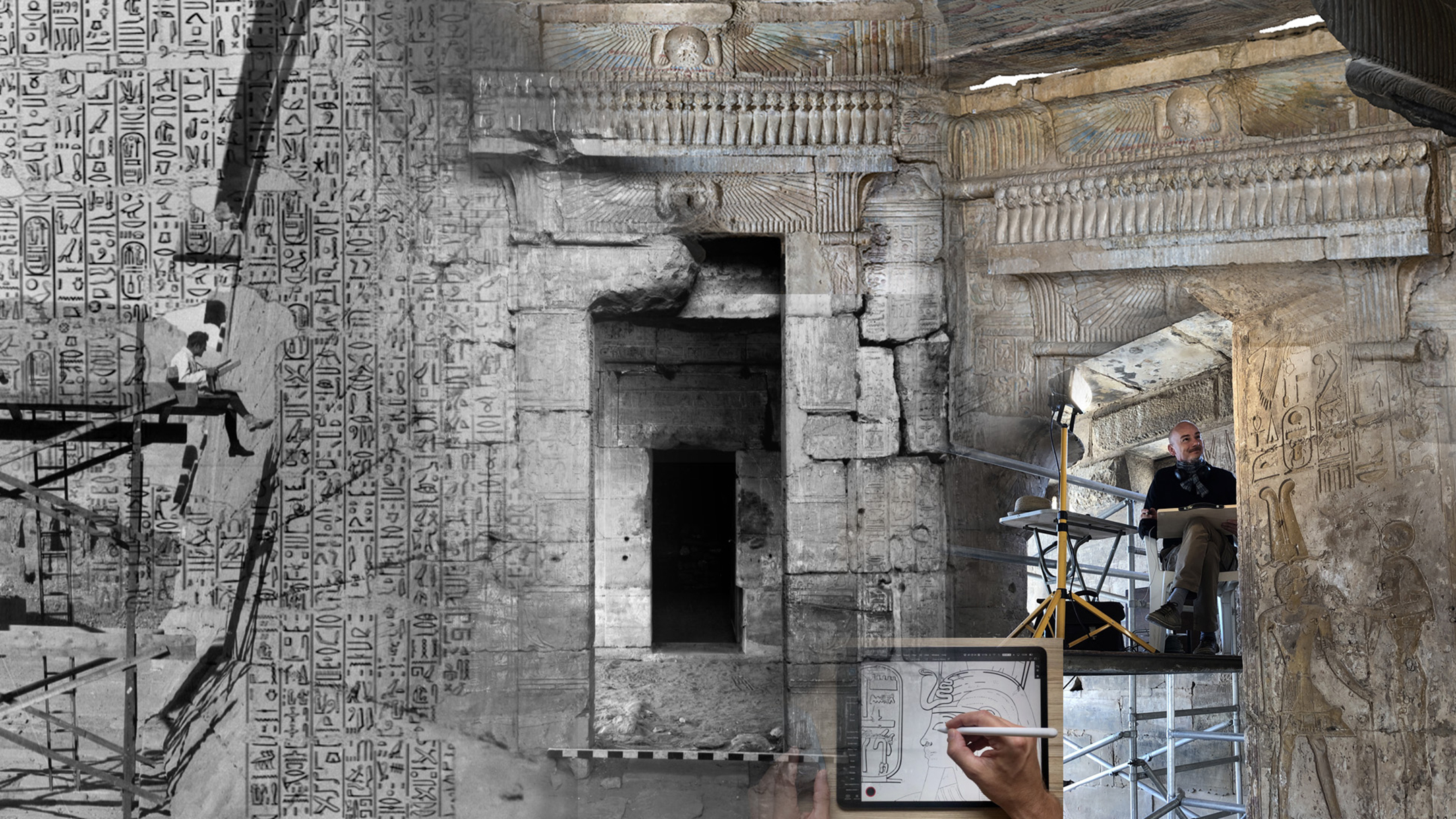
Collage of Chicago House archive large format photographs (Negative #: 208, 391, 1360) with recent 3D models and photo documentation from K. Vértes & O. Murray
This article uses the Survey’s first ever “digital native” prototype to explore how the rapidly evolving field of digital and 3D publishing may work in concert with print publication to further the original aims of the project. In particular it will look at preliminary work adapting for-print 2D data for online 3D presentation and reflect on questions of how, when and where these technologies can be used, and how such technologies intersect with the needs, aims and ethos of the Chicago House approach.
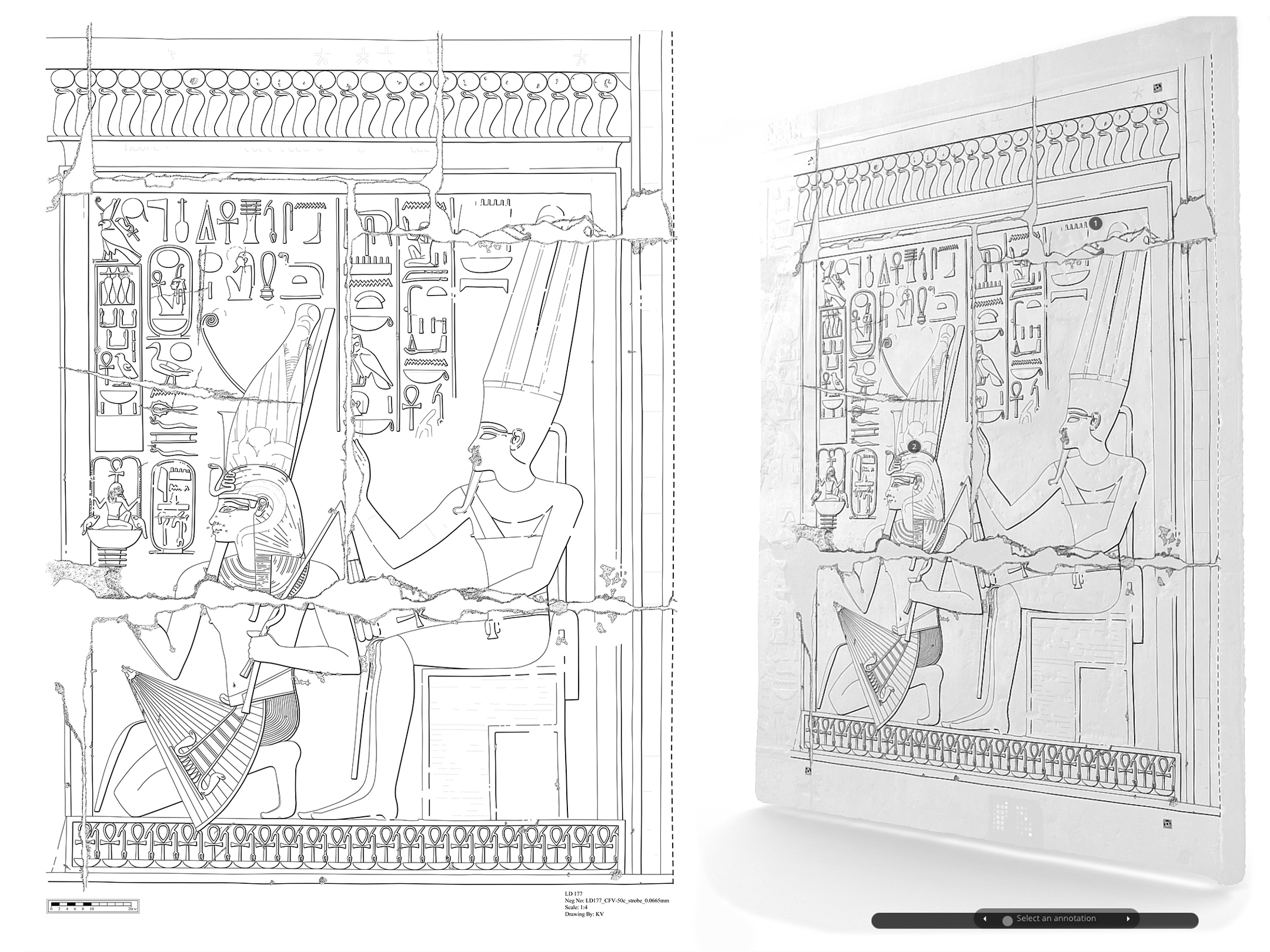
LD 177 Finished Illustration for print (left) reprojected onto a model dataset for 3D publication using the SketchFab platform (right)
Background
James Henry Breasted’s early fieldwork in Egypt identified that many copies of hieroglyphic inscriptions made during the 19th century by some of the pioneers of the field were inaccurate; an observation that was further compounded by the fact that some of these same inscriptions were rapidly deteriorating, and at risk of becoming lost forever. Though photography loomed large on the horizon, promising a solution to this documentation problem, Breasted quickly saw through the illusion and realized that even the best crafted photos were subject to limitations such as single directional lighting. Even the mediums’ greatest strength - objective impartiality - was itself a weakness, because it placed equal emphasis on all surface elements. What carried meaning and could be selected and highlighted by careful study in the field – partially damaged hieroglyphs, eroded internal details of signs or figures, traces of earlier decorative stages, or faded paint lines - remained all but invisible in a photograph.
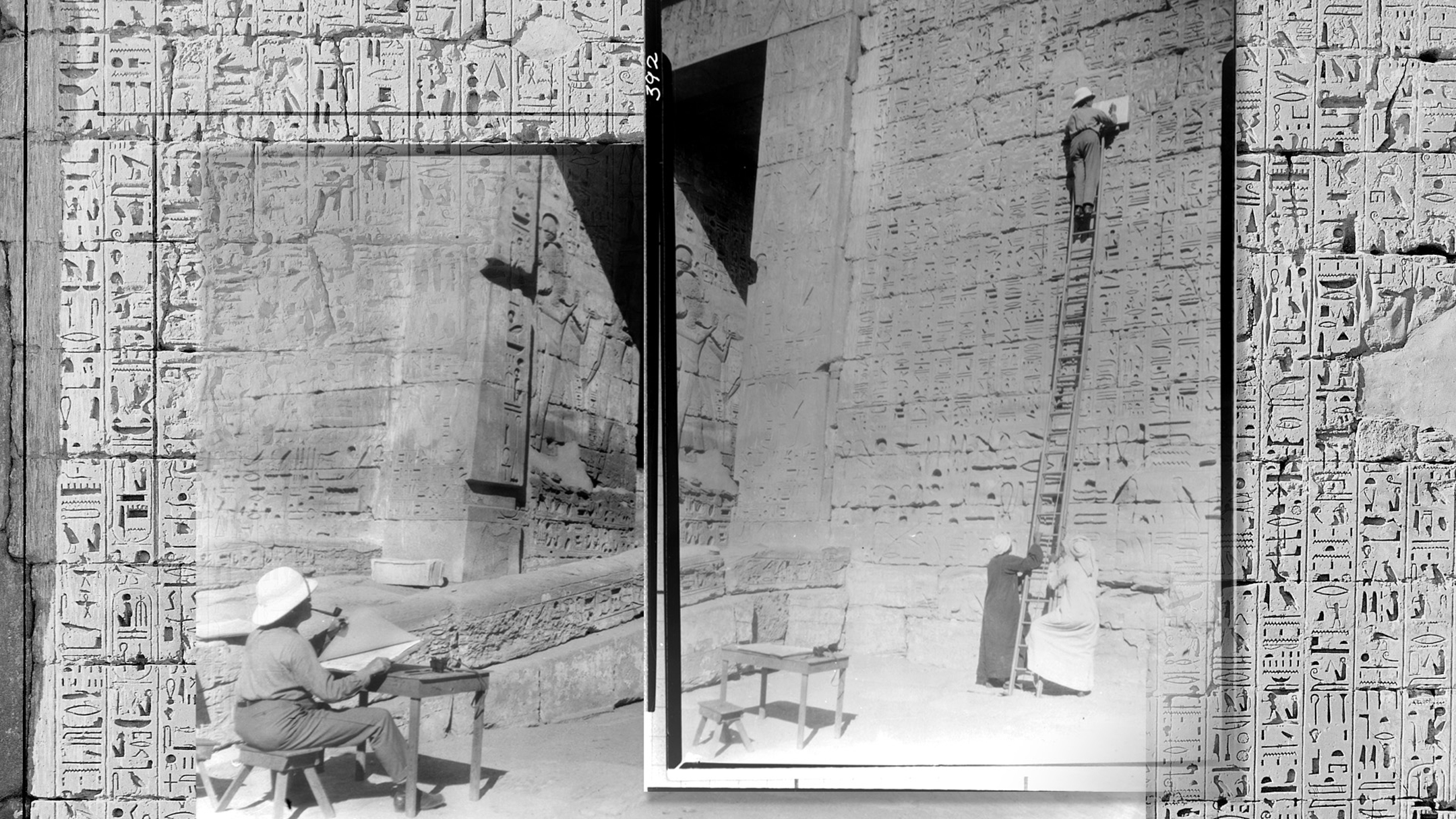
Collage of Chicago House archive large format photographs (Negative #: 101, 390, 392) showing Breasted at Medinet Habu while inspecting a collation package (left) and atop a ladder (right)
An Egyptologist’s observation and interpretation of an inscription was needed to highlight historically significant features, while ameliorating distracting elements such as damage or discoloration. The synthesis of these observations and interpretations would be delivered via a high-quality facsimile line drawing in which inscribed and/or painted elements were given priority. To achieve this, the skills of an artist trained in scientific illustration techniques would be required to lay down the details with enough care and accuracy so as to provide a true representation of the inscription.
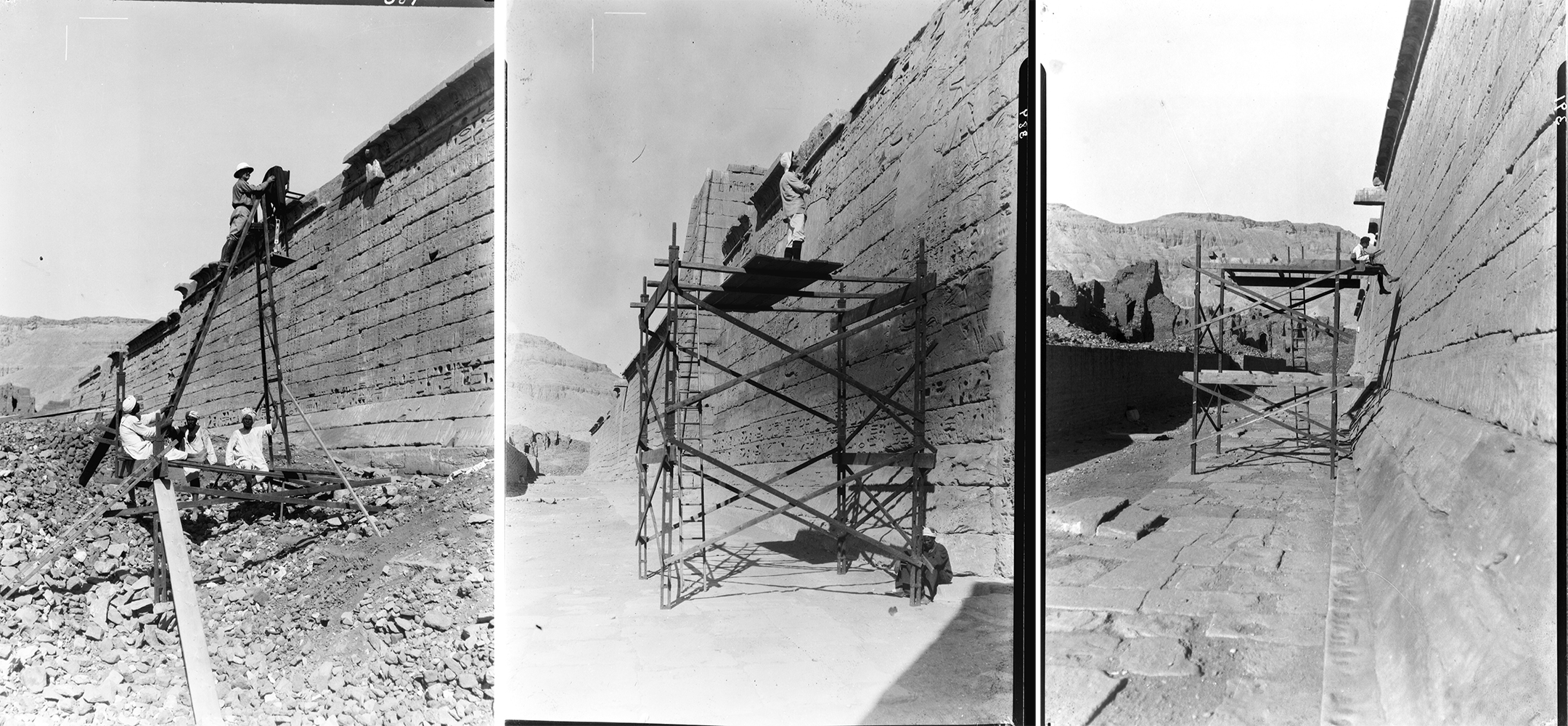
Chicago House archive large format photographs (Negative #: 387, 389, 391) showing the disciplines involved in the Chicago House Method at its inception, continued to this day: photographer, artist, philologist
Photography would provide accurate proportions and scale, an Egyptologist’s philological knowledge and inspection would reveal historic significance, the artist’s hand would set forth these observations for posterity, the fruits of their combined labor acts of scholarship, art and conservation unparalleled.
In 1924, at the inception of the Epigraphic Survey project, Breasted pioneered this novel solution to accurate epigraphic documentation. It has come to be known as the Chicago House Method, detailed explanations of which have been given by Breasted (1933), Hughes (1952), Bell (1987), Dorman (2008), Johnson (2012), and most recently, McClain (2020).
Digital Native
During the intervening 97 years, the disciplines and interactions that underpin the Chicago House method have remained bedrock, none more so than the series of checks and discussions in situ. As McClain (2020) emphasizes, “in order to extract and record the maximum amount of information from an ancient, decorated wall surface there is no substitute for taking time to make multiple examinations of the wall, with multiple collations of the copy against the original.” With this guiding principle in mind, the technical elements of the Chicago House Method can, and have, been modified for various field conditions and types of inscribed relief. The proliferation of the internet and various digital technologies and toolsets that accompany it are no exception, and perhaps an example of one of the most permanent field condition shifts since the early years of Egyptology and introduction of the daguerreotype photography process by the French Academy of Sciences in 1839.

Senior Digital Artist Krisztián Vértes & Epigrapher Dr. Jonathan Winnerman discussing LD 177 (K. Vértes)
Since 2014, the Survey has worked on configuring a digital epigraphic workflow from start to finish that conforms to the above guiding principle, and the focus of Expanding Digital Epigraphy: developing a digital collation process presented by A. Singer (2021) at the ARCE 2021 annual meeting (read A. Singer - On Developing a Digital Collation Process… here).
LD 177 in Luxor Temple: Amun-Re Establishes Amenhotep III’s Double Crown, represents the first scene to have passed through the digital epigraphic workflow; from photogrammetric capture and rectified orthomosaic image, through digital tablet drawing, inking, collation, artist and director checks -- the first digital native.
3D Field Model
In order to produce a rectified orthomosaic image of LD 177 required in the initial stage of the digital epigraphic workflow, photogrammetry was employed. A series of four coded targets were placed in four corners surrounding the scene and affixed using double sided tape with a minimal adhesive. The targets were measured and recorded. An x-rite color checker was placed on the wall for color calibration in post-process as well as to provide a measurable scale. A Profoto studio strobe set up outside of the scene provided raking light from the upper left for a set of 29 photos that were then taken with a Mamiya RZ67 Pro IID and Mamiya-Sekor Z 50mm f/4.5 mounted with a Hasselblad CFV-50C digital back. Images were shot handheld from a distance of 1.5m from the wall. From the set of 29 photos, 12 were structural, taken at oblique angles to the scene, while the remaining 17 facing, or textural photos, were shot perpendicular to the scene. Raw photos from the Hasselblad CFV-50c were catalogued and processed in Adobe Lightroom and then exported as high-resolution jpegs with a lens profile calibration specific to the 50 mm Mamiya-Sekor Z f/4.5 applied to each image.
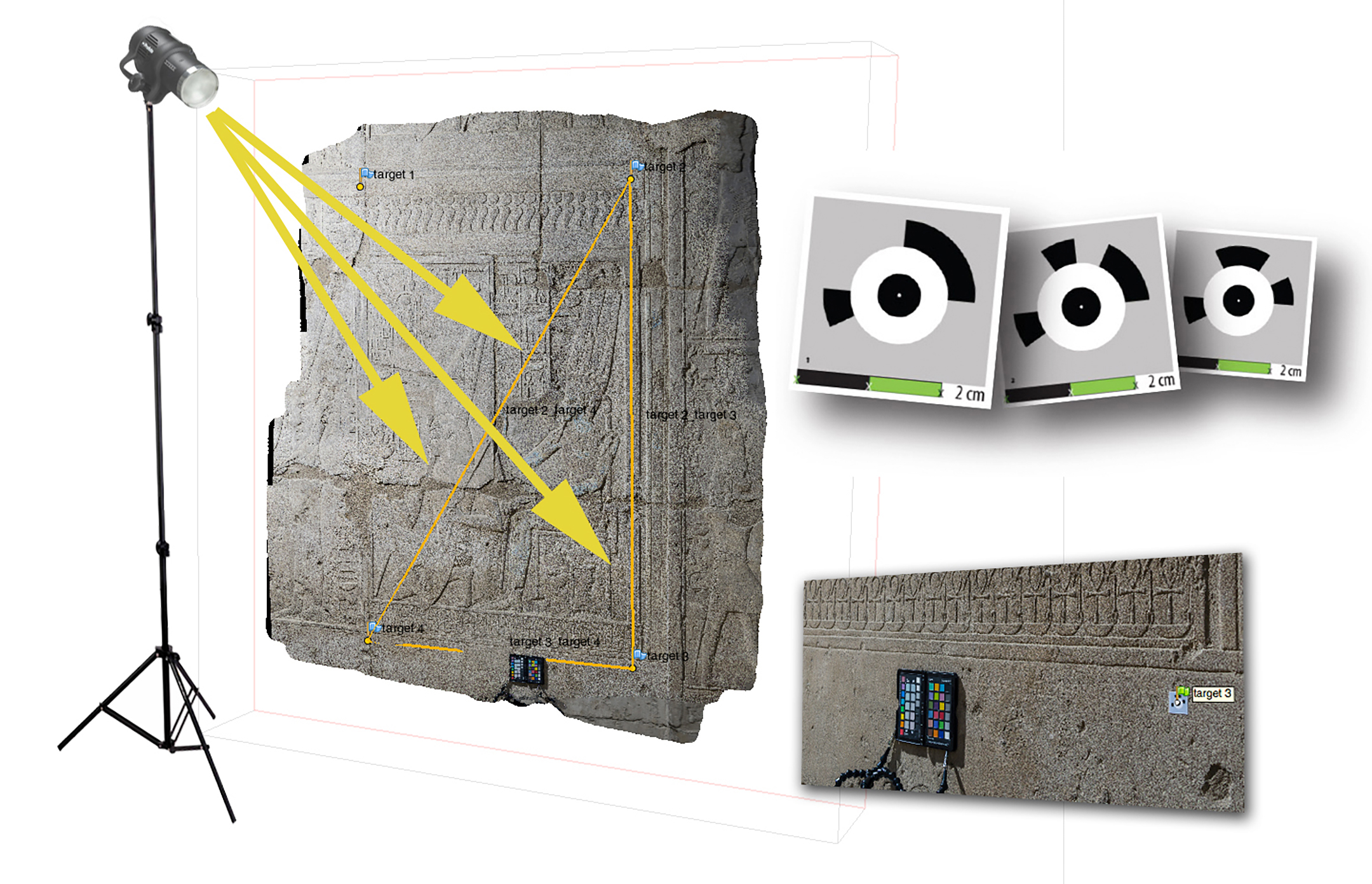
Lighting, targets and color checker used for LD 177 photogrammetry (O.Murray)
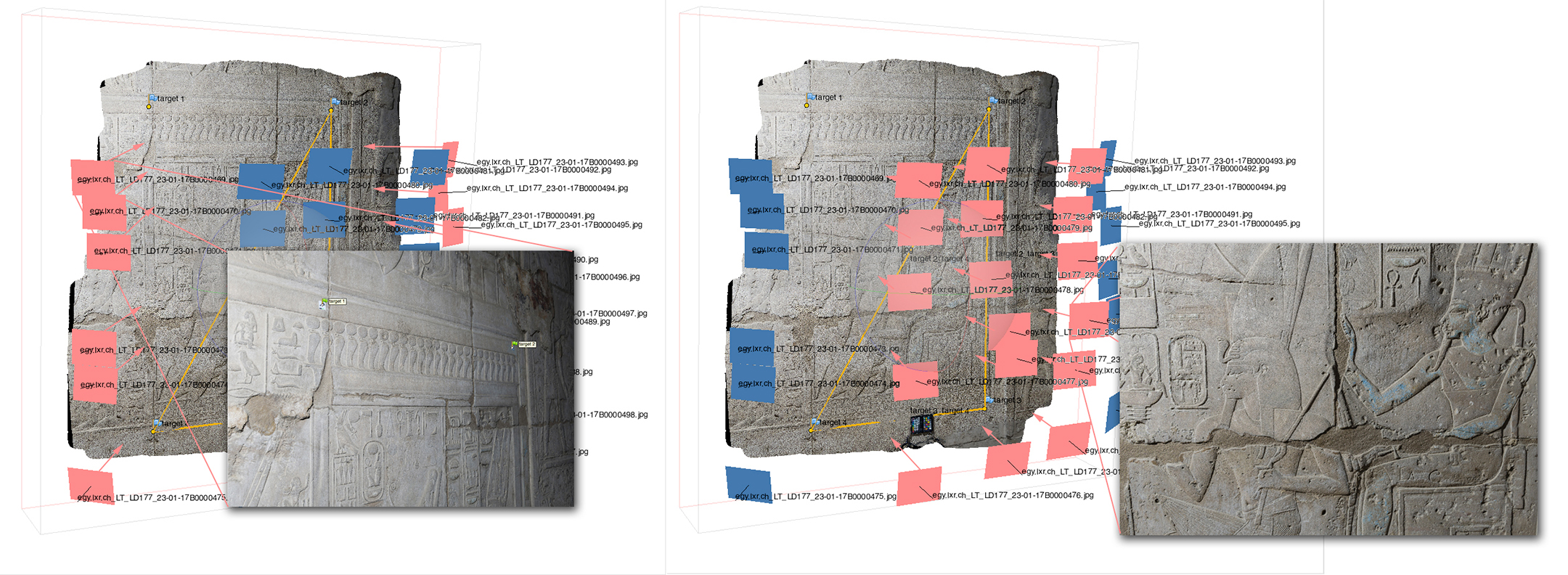
Camera positions (stations) used to produce the LD 177 photogrammetric model (O.Murray)
The photos were imported into Agisoft PhotoScan (now Metashape) and the coded targets were automatically identified with their positions refined in each photo as required. Scale bars were created from the target measurements and camera stations were optimized resulting in very low error margins. The photos were aligned on low to produce a sparse cloud with 32K tie points, from which a low-quality dense cloud of 4M points was produced. A low poly mesh was then built with 91K faces and textured at 8K. Using the coded targets to define the projection plane, an orthomosaic was created of the scene and exported as a high-resolution tiff @ 0.0845mm/px. This millimeter to pixel ratio delivers a 1:4 @ 1200ppi file required for the drawing enlargement. (This ratio has since changed to 1:4 @ 400ppi).
LD177 - Photogrammetry sample - detail (Click photo to discover in higher resolution)
Artist Krisztián Vértes then penciled and inked LD 177 according to digital epigraphy guidelines and the scene passed through all stages of the Chicago House method digital epigraphic workflow as detailed in A. Singer’s presentation.
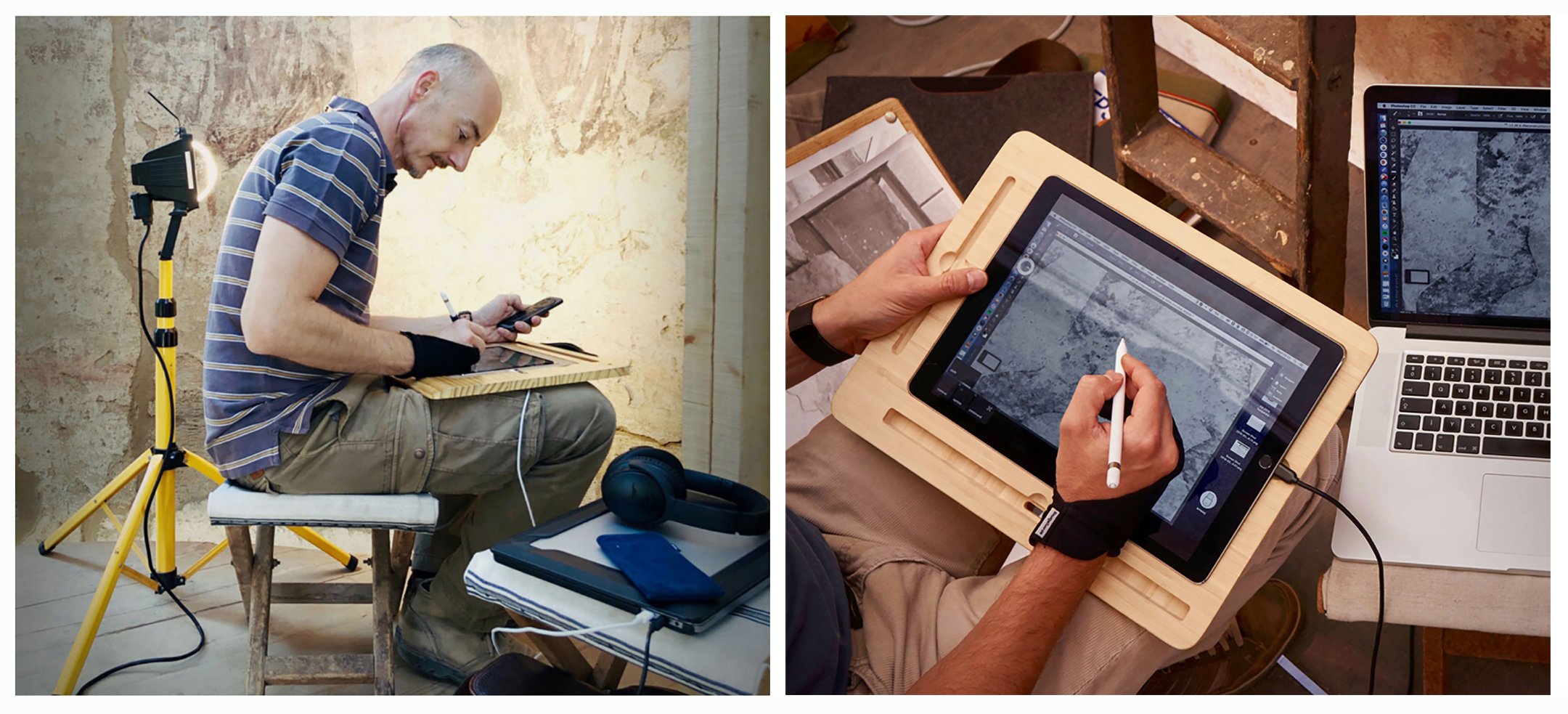
Krisztián Vértes penciling on an iPad Pro in the Imperial Cult Chamber at Luxor Temple (K.Vértes)
LD177 ready for collation - detail (Click photo to discover in higher resolution)
3D Publication Model
The final director checked illustration was re-imported to the PhotoScan/Metashape field model and aligned and reprojected onto this model using the same four targets used to derive the initial measurements and PhotoScan/Metashape scale bars. The texture was rebuilt once using the set of 29 photos, and then -- keeping the same UV mapping/space -- once using only the single finished illustration. Due to the already low 91K face poly count, the field model was exported for publication as is, in an .obj format, resulting in a publication ready model and two textures, one photo and one illustration.
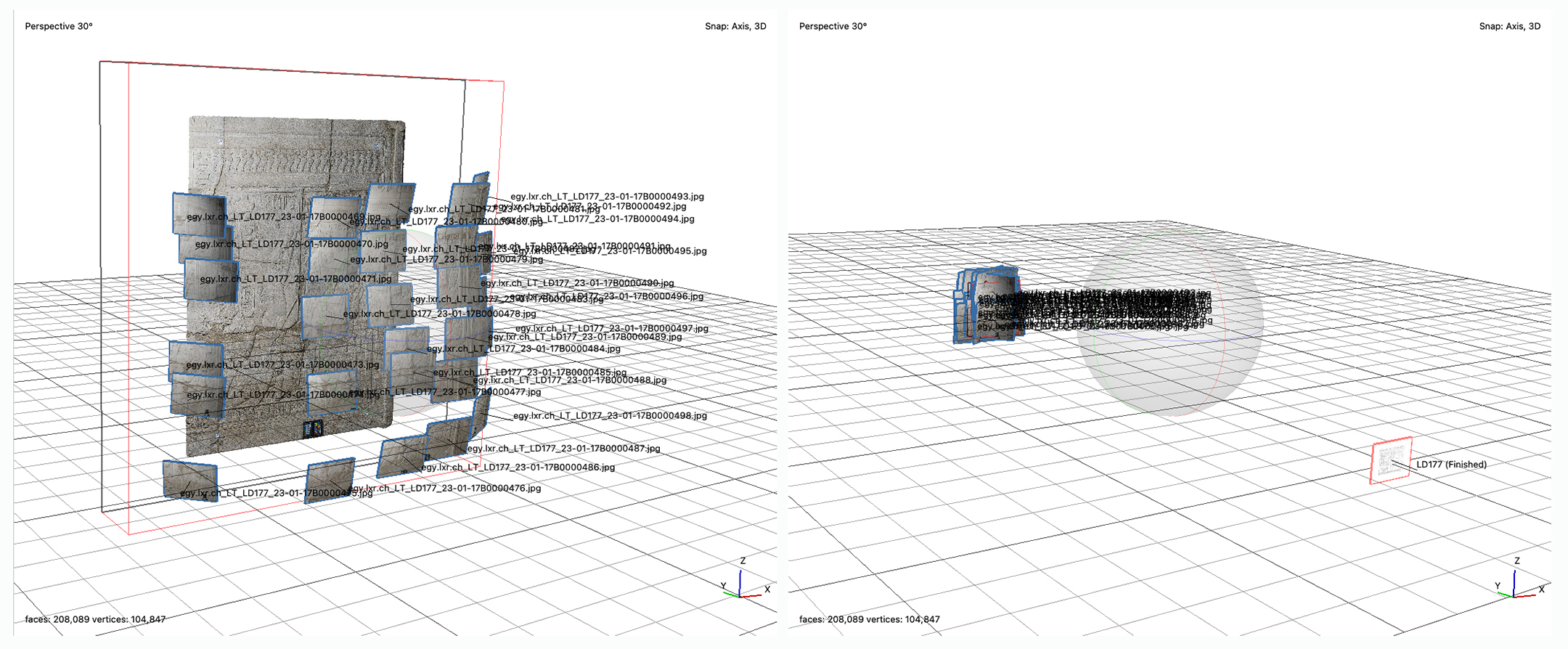
Screen shots showing the 29 photos used to build the LD 177 photo texture (left) and the finalized illustration after alignment and reprojection used to build the illustration texture (O.Murray)
While capture of 3D data is increasingly common, publication can still remain problematic. Self-hosting with technologies like 3DHOP and Potree are two of many options, but by far the most prominent platform (at the moment) is SketchFab. While the standard viewer has its limitations, the service provides an API to allow for customization within a self-hosted html page and many pre-made viewers or ‘configurators’ are available on the SketchFab marketplace. However, none of the pre-made options offered exactly what was desired – the ability to fade between two textures; from the facsimile illustration to the photographic data and back again to more directly facilitate comparison between the data and the interpretation. To achieve this, we trialed two different approaches. The first allowed swapping textures live – that is a user could upload their own line drawing onto the model and fade between it and the original texture using a simple slide control. This approach came with a significant performance cost, so instead we took advantage of SketchFab’s own texture and display optimizations and hid the final inked illustration inside the ‘emission channel’, itself located inside the SketchFab PBR (Physically Based Render) texture settings. Then we simply used a custom html page slider to mimic the controls inside SketchFab’s own settings.
The results have been more than encouraging and provide a way of transitioning between photo texture and final illustration while enabling a deeper scrutiny between the two within a 3D publishing context. Though only a prototype, this configurator provided a fruitful case study for considering the needs and requirements of the Survey’s online publishing efforts. Exploratory in nature, these results have helped us think through the process and provide ground for further discussions. (Interested? Give it a try and let us know how it goes!)
Value Add? How, When & Where
The above model represents a very thin slice of just one 3D publishing platform from just one area of Egyptological inquiry that may be used to disseminate, educate and inform. In framing its usefulness and potential (or lack thereof) a broader question may be posed: what is the value add of digital publications for Egyptology in general?
By no means definitive, our preliminary working group has come up with a few responses. In practical terms, two different streams of digital publications have been identified: Digital Editions and Digital Natives.
Digital Editions
Digital Editions would entail reproducing a traditional publication in a digital way – maintaining the original level of quality, if not increasing it, and making it accessible both online and offline, through data caching and download options. It would allow for better quality reproduction than can be achieved in print, and include zoomable images, side-by-side comparisons, annotation and other features. Various platforms and tools are already available with increasing support and uptake within the wider heritage sector; many of them open source. Adopting existing toolsets such as these will only encourage and reinforce data sharing standards and accessibility. Good examples of this can be seen with project mirador and the Getty Conservation Arches platform.
It is worth stating that the majority of digital pdfs available at the moment are not considered to be digital publications by the definitions of our workgroup. Though they are accessible on the web, most are the equivalent of a B&W photocopy, with a level of quality that reflects as much.
However, it is also worth stating unequivocally that nothing will ever replace a traditional paper bound volume held in one’s hands and read in person. These publications are, and will remain, invaluable in-and-of themselves, if for nothing else than grounding us in the physical realm from which the subject of their inquiries originate – not to mention as failsafes against data corruption, inaccessibility, host issues, server failure, etc. The virtual realms which hold so much publication possibility are only accessible from our shared physical reality and proximity to each other – nothing is a better reminder of this than the printed page.
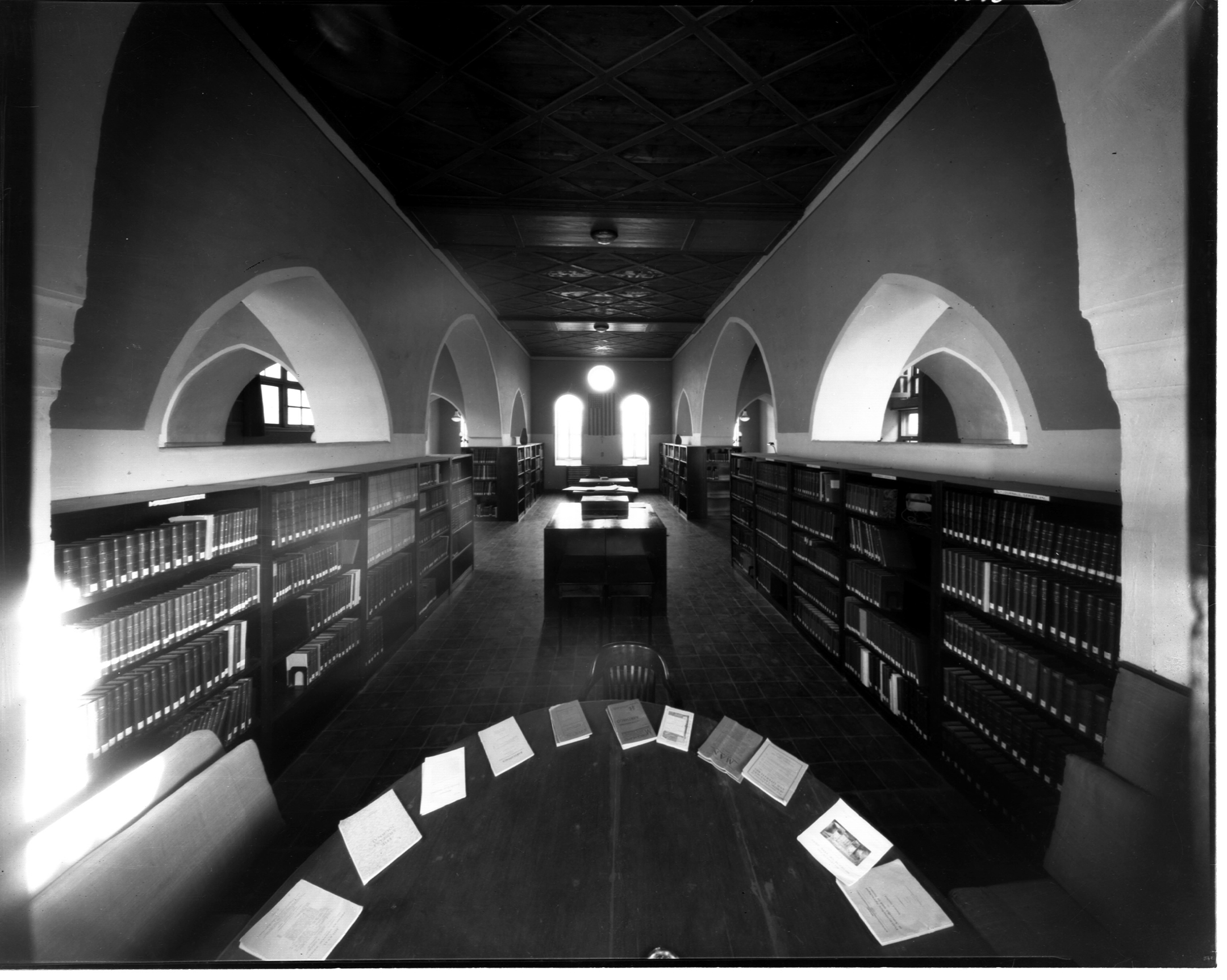
Chicago House archive large format photograph (Negative #: 1080) showing the original West Bank Chicago House Library
That said, the value adds with Digital Editions for the Egyptological community in terms of the communication and dissemination of knowledge are clear: cost, scope, accessibility and better control of the publication process vs. traditional book publication houses. Lower production and overhead costs, better quality reproduction (even in downloadable formats) with links and references that can be constantly updated, alongside clickable footnotes would be of real benefit.
Perhaps the last value add lies in what can be seen most recently; as a source of resiliency. In times when libraries are closed, Digital Editions and the sites that host them could foster and support the Egyptological community, allowing research, reference and interactions to continue virtually until the community can once again rejoice in shared physical spaces, and research grounded by the smell, touch and pleasure of paper-bound volumes.
Digital Native Publications
The second stream of Digital Publication encompasses a terrain much more vast and not nearly so well defined – that is: Digital Natives. In recent years 3D capture has become an integral part of what was traditionally a 2D workflow, but this 2D output can also be reunited with the 3D data it is based on with relative ease. This 3D data, in turn, opens up myriad avenues for publication, but not without limitation. The impartiality of photography noted by Breasted nearly 100 years ago remains much the same with SfM documentation techniques today. The illusion of reality in these mediums, combined with a mindset that approaches them as being a one-stop documentation solution, has in many ways only compounded, as this illusion has now sidled into the third dimension. Virtually real, or really virtual? (Huggett, 2019).
LD 177 Publication Model showcasing Sketchfab api adjustments in combination with the native Sketchfab wireframe model inspector element
In order to set a course insofar as 3D publication is concerned, not succumb to the illusion of reality, all while side-stepping the many Pandora-esque possibilities, it is worth evaluating how these many possibilities fit with the original aims and vision of James Henry Breasted and the Chicago House method. As current Chicago House Assistant Director Brett McClain (2020) surmises, Breasted’s vision of Chicago House efforts were, “to provide a published volume that could stand in place of the original (or section thereof), making these ancient records widely available for scholarly research and preserving them for the future.”
Anyone who has picked up a large print folio of a Chicago House publication will realize the quality and attention to detail that goes into these publications and the value inherent therein. Though these publications might benefit from a Digital Edition in order to complement the potential and quality held within the physical print volume, it is self-evident that these print volumes do justice to the aims and efforts of the original mandate. Not only are the facsimile line drawings beautifully rendered, but they also contain within a synthesis of photographic precision rendering accurate proportions, as well as clarifying what is undetectable without rigorous inspection in the field, followed by a series of conversations between subject matter experts after the fact, not to mention research into parallels these specialized philologists have completed beforehand. They stand unparalleled in the field, precisely because of these elements, and the time, dedication, knowledge and craft that has been poured into them.
At their best, we see Digital Natives as a source of augmentation, exploring the many possibilities that exist for 3D outside of the more clearly defined “digital translation” process encompassed by Digital Editions, and working in complement with traditional print volumes. We believe the driving question at the core of further, and future 3D publication should be: What can 3D publication provide that traditional 2D publications cannot?
One can understand that within this framework, the LD 177 example presented above is just the tip of the iceberg and affords an exciting possibility in conveying contextual relationships of various inscriptions within monuments that are apparent in person (perhaps only after repeated and extensive visits) but that simply cannot, or are otherwise incredibly difficult, to communicate to either academic or layman audiences via traditional print publication.
Courting Pandora for Posterity
Insofar as the Chicago House method is concerned, the value of taking time to make multiple examinations of the wall, with multiple collations of the copy against the original is paramount, and the manner in which the results of this documentation highlight, clarify and relay the inscribed information in a facsimile line drawing is unparalleled. But what happens if and/or when, these monuments are not physically accessible to the practitioners of the three disciplines so integral to their documentation? Is there a way of recording these monuments using current digital data capture techniques that would permit future artists and epigraphers to study the surfaces in the depth and detail necessary to draw both facsimile line drawings, and the necessary conclusions about the nature of the inscribed material, not to mention have a series of conversations about the material, as though they were in person?
In setting foot squarely in front of Pandora’s box once more, we must state at the outset that nothing can ever replace access to the actual, physically tangible object. With that in mind, pursuing the question posed above may be of no use, for data capture for a monument no longer physically present raises all sorts of further questions – namely: what are the known limitations of such type of recording? What are the things we don’t know that we’re using that inform our senses and perceptions of any given monument at any given moment? How, and to what degree, are we aware of our limitations? To paraphrase Rumsfeld: what are the known unknowns, and what are the unknown, unknowns? Ultimately, where do we draw the data recording line at?
In attempting to answer these questions it is worth considering the way that technological trends are poised to move within the next 5-10-15-year time frame. It could well be that AI produces results that mimic what the survey produces aesthetically — but it is clear that without the knowledge of a specialized philologist with access to the original, this type of documentation would be a pale comparison. What is beyond doubt is that the pressures to adapt to this type of documentation will only increase as machine learning and AI technologies become more prevalent. In this regard, looking back may be the best way forward. Just as Breasted realized the potential of photography, incorporating it into a solution, rather than making it the only solution to Epigraphic documentation, so will we; using technology to augment our perceptions and extend our abilities to see even more than we can at the current moment, but never replacing our faculties and ability to think, perceive the nature of, and engage in, our shared reality.
How will computers be able to augment our perceptions and extend our abilities to see even more than we can at the current moment? In terms of documentation in the near and mid-term future, what sort of things really matter to us as researchers – as humans? How do we use technology in the service of narrative, rather than to become an avatar for reality?
We don’t have the answers, but we believe these types of questions are worth considering. In a very general sense and in purely speculative terms – and as informed by the scope of the Epigraphic Surveys mandate – any data-capture techniques that were to happen asynchronously of the efforts of the artists and epigraphers in person, but affording them repeated examination in a virtual environment, would require millimetric accuracy, full color visible spectrum documentation, and a baseline resolution of at least 1:1 @ 300ppi. Moreover, a digital sandbox with the ability to position and move multiple lighting sources in various combinations after the fact would be essential. As with the results of the Survey’s current documentation programs, this would require a level of quality unsurpassed, as there is a very real difference between the functional understanding required from such an endeavor vs. the experimental sharing and narrative of which most online or virtual models can currently be classified.
Conclusion
In stepping back from the brink of bits and bytes of data and ineffable conundrum of virtual realities, replete with both possibility and pitfall, it is worth considering how best to preserve a monument (or section thereof) for future generations. Just as it is inevitable that the monuments to which so much documentation attention has been turned are in a constant, progressive state of decay, so is the inevitability of change in the techno sphere. Over time, the means, manner and techniques employed in any documentation pursuit will change. As McClain (2020) notes, “it is inconceivable that all of Egypt’s monumental heritage, with its great quantity and variety of textual and iconographic records, could be documented at such a high level of accuracy and detail as is characterized by the Survey’s publications. Though Breasted may not have been able to imagine the possibilities enabled by current digital toolsets, had they been at his disposal, he would have used them wisely. As McClain clarifies, [Breasted’s] vision was that a representative selection of the most significant Pharaonic records should be documented and published in an optimum fashion. As is the case for 2D publication, so is the case for 3D publication.
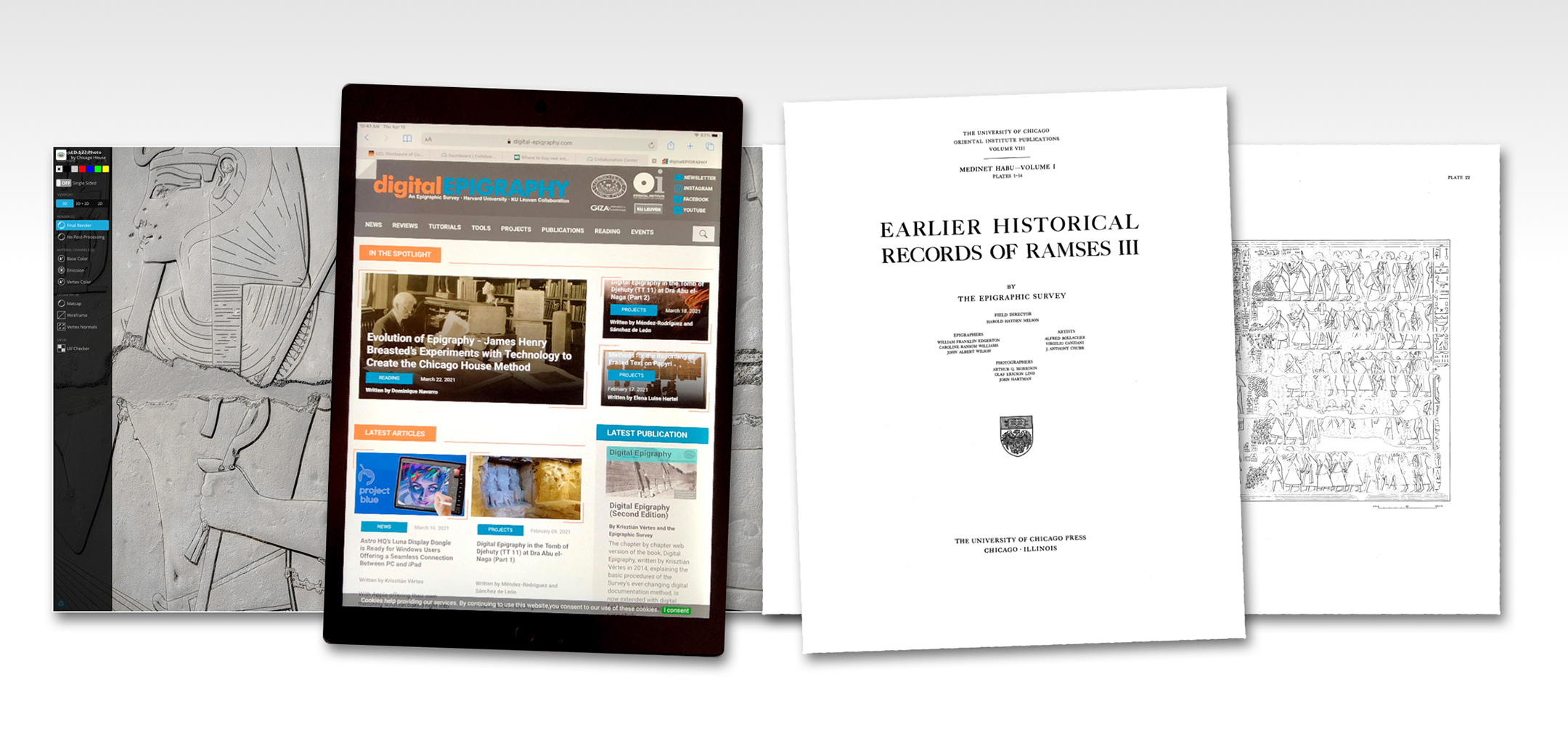
Digital Edition and Digital Native Publications working in tandem with traditional print publications. (Left: digitalEPIGRAPHY, an Epigraphic Survey, Harvard University & KU Leuven Collaboration. Right: University of Chicago Oriental Institute Publications Vol. VIII)
Regardless of era, time and place we are always in face of the inevitable. We believe that one potential guiding principle as relevant today as it was 100 years ago, as it may be 100 years from now, is to aim for beauty in all efforts, and acts, of preservation. One honors the past and leaves the best record for the future by creating something beautiful in the present. That beauty remains cliche; in the eye of the beholder, and subjective across gender, culture, class, religion, nationality, institution and sexual orientation, to name but a few, with a multiplicity of interpretations, is its greatest strength. Through this plurality of interpretation, regardless of output -- united and harmonious in the effort and act of pursuing beauty -- will come the truly unique means of documentation that hold value for future generations escaping the ever-present ephemera of the world in which we live, and they will inherit.
Part of the reason there is value in ancient Egyptian artifacts and monuments is because of the beauty, craft and ingenuity of how they were made. They stand testament to the mindset of wider civilization that never ceases to pique our curiosity in all facets of life, spanning thousands of years — not just royal processions but the day-to-day activities of the workers and craftspeople who worked tirelessly to produce the very objects and monuments investigated to this day.
Many of these monuments can be seen themselves as an act of publication — read and interrogated as a book. In turn, in writing ourselves into the record — we want to inject the same beauty, craft and ingenuity into what we leave. Indeed, we must, if these documents are to stand in place of the original.
The beauty of the epigraphic documentation that Chicago House provides and has provided for the past 97 years is not limited to aesthetics per se – it is a blend of artistry underpinned by scientific methods of observation and recording, that in turn forms a visual repository for the knowledge of the craftsman and scholars involved. This vessel becomes an emissary: from the past through the present, to the future – a thin, multidisciplinary line. The Egyptological community’s publication efforts present and perpetuate ancient Egypt, but they also represent the present. By producing something that future generations may, in turn, want to preserve, we are not only saving something of ancient Egypt, but we are also saving a piece of ourselves, not to mention the discipline.
We are excited by the possibilities of digital publications falling into the two main streams of Digital Editions, and Digital Natives and see these as worthwhile pursuits in tandem with traditional print publications. By utilizing existing platforms and API resources, LD 177 demonstrates but just one small possibility of digital native publications in general.
Regardless, may beauty be recognized in how these publication efforts stand in service to the originals, preserving them for future generations and making the results of these efforts available for scholarly research, and the general public at large.
Note: The Sketchfab Texture Swap was conceived, designed, coded and is kindly made available by, Alexis Pantos. We encourage any and all whom may benefit from its use to try it out and leave us comments below!
References:
Bell, L. 1987. “The Epigraphic Survey: Philosophy of Egyptian Epigraphy after Sixty Years’ Practical Experience.” In Problems and Priorities in Egyptian Archaeology, edited by J. Assmann, G. Burkard, and V. Davies, 43–55. London.
Breasted, J. H. 1933. “The Epigraphic Expedition.” In The Oriental Institute, 187–223. The University of Chicago Survey XII. Chicago.
Dorman, P. F. 2008. “Epigraphy and Recording.” In Egyptology Today, edited by R. H. Wilkinson, 77–97. Cambridge.
Huggett, J. (2019). Virtually Real, or Really Virtual: Towards a Heritage Metaverse? Studies in Digital Heritage, V.4, N.1 (1-15). https://doi.org/10.14434/sdh.v4i1.26218
Hughes, G. R. 1952. “Recording Egypt’s Ancient Documents.” Archaeology 5:201–204.
Johnson, W. R. 2012. “The Epigraphic Survey and the ‘Chicago Method.’” In Picturing the Past: Imaging and Imagining the Ancient Middle East, edited by J. Green, E. Teeter, and J. A. Larson, 31–38. OIMP 34. Chicago.
McClain, J. B. (2020). The Chicago House Method. In V. Davies & D. Laboury (Eds.), The Oxford Handbook of Egyptian Epigraphy And Palaeography. (Chapter III.4, pp. 557–580) https://doi.org/10.1093/oxfordhb/9780190604653.001.0001





0 comment(s)
Leave a comment(We'll keep your email address private)